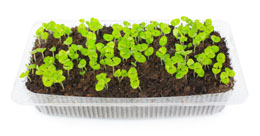It is inexpensive to grow plants from seeds, and growing them indoors is beneficial for those who stay in regions with a brief growing season.

Spring is the time to plant your garden. In some regions, this season is too brief due to the late arrival of the last frost. In such cases, it will be beneficial to grow seeds indoors, so that you will be ready with young plants as the growing season begins. If you wait for the growing season for sowing seeds, slow-growing plants may suffer, as they may not bloom or produce fruits and flowers before the first frost. This method is more beneficial for plants, like tomatoes and peppers, that require a long and warm growing period, for a good yield.
First of all, plan your garden layout, and prepare a list of plants you want to grow. Start collecting the materials required for the task. The most important raw material is the seeds. Others include containers for growing seeds. You can use sophisticated and specially designed germination trays for growing seeds. You may also opt for inexpensive options, like paper cups, yogurt containers, egg shells, etc., provided they have good drainage. You need some sterile seed starting mix too.
- While some seeds require more time to germinate, others take very little time. So, plan accordingly. Some of the seeds have to be sown at least 12 weeks before the last frost. Others can be sown two weeks before the last frost.
- Punch holes through the bottom of the containers, so as to ensure proper drainage. Before adding the seed starting mix, you have to sterilize the containers by washing them in warm water.
- Add sterile seed starting mix, which is considered best for growing seeds indoors. It contains no soil and so, you can prevent diseases in the baby plants. You may also use a mixture of perlite, vermiculite, and peat. However, it is better not to use ordinary garden soil, so as to avoid soil-borne diseases.
- Once the container is ready with proper drainage facility, and is filled with seed starting mixture, you can sow the seeds. You must follow the instructions given in the seed package, as the depth of planting seeds may vary from one type to another.
- In general, it is said that bigger seeds have to be planted deeper than the smaller ones, and very small seeds, have to be scattered on the surface of the starting mixture.
- Once you are done with sowing, water the containers gently. Don't soak the mixture in water. You can either keep the containers in a tray filled with water, or sprinkle small amounts of water at regular intervals.
- Check for the temperature requirements of the seeds in the seed packet. Some may need warm temperatures, while others require cool settings. Place the containers in locations, which provide the perfect temperature settings for seed germination.
- You may also place the containers in closed plastic bags, in order to conserve moisture. In such cases, water droplets may appear inside the bag. Keep the bag open for short intervals. Check the containers regularly, and once the seeds germinate, remove the containers from plastic bags, and place them on windowsills, or other indoor locations, where there is bright light.
- You may also place the growing seedlings under lights, so that they get at least 14 to 16 hours of light exposure per day. Lighting systems that are specially made for this purpose, are also available in the market.
Make sure that there is no danger of frost, as you prepare for planting the seedlings in the garden. Wait till the outdoor temperature reaches about 50° F, at night. Before transplanting, water the seedlings as well as the locations, where you plan to plant the seedlings. It is better to transplant them in the evening, when there is no direct sunlight. Water the baby plants, as soon as you transplant them, and continue watering them everyday for one week. You can reduce the frequency of watering, once the plants get adjusted to the outdoor atmosphere.






 Spring is the time to plant your garden. In some regions, this season is too brief due to the late arrival of the last frost. In such cases, it will be beneficial to grow seeds indoors, so that you will be ready with young plants as the growing season begins. If you wait for the growing season for sowing seeds, slow-growing plants may suffer, as they may not bloom or produce fruits and flowers before the first frost. This method is more beneficial for plants, like tomatoes and peppers, that require a long and warm growing period, for a good yield.
Spring is the time to plant your garden. In some regions, this season is too brief due to the late arrival of the last frost. In such cases, it will be beneficial to grow seeds indoors, so that you will be ready with young plants as the growing season begins. If you wait for the growing season for sowing seeds, slow-growing plants may suffer, as they may not bloom or produce fruits and flowers before the first frost. This method is more beneficial for plants, like tomatoes and peppers, that require a long and warm growing period, for a good yield.